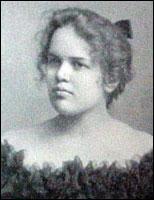- Adelaide Crapsey
Infobox Writer
name = Adelaide Crapsey

caption = Adelaide Crapsey
birthdate = 1878
birthplace =Brooklyn, New York ,United States
deathdate = death year and age|1914|1878
deathplace =Rochester, New York ,United States
occupation =Poet
nationality = AmericanAdelaide Crapsey (
September 9 ,1878 –October 8 ,1914 ), was an American poet. Born inBrooklyn , New York, she was raised inRochester, New York , daughter of Episcopal priestAlgernon Sidney Crapsey , who had been transferred from New York City to Rochester, andAdelaide T. Crapsey .She attended public school in Rochester, and then
Kemper Hall , an Episcopal girls' preparatory school inKenosha ,Wisconsin , before enteringVassar College in Poughkeepsie, New York, graduating in 1901.That same year her sister Emily died, and Adelaide delayed starting her teaching career for a year. In 1902 she took a position at Kemper Hall, where she taught until 1904. She then spent a year at the School of Classical Studies at the
American Academy in Rome .In the years before her death, she wrote much of the verse on which her reputation rests. Her interest in rhythm and meter led her to create a variation on the
cinquain (or quintain), a 5-line form of 22 syllables influenced by the Japanesehaiku and tanka. Her cinquain has a generally iambic meter and consists of 2 syllables in the first and last lines and 4, 6 and 8 syllables in the middle three lines, as shown in the poem [http://www.niagarapoetry.ca/crapsey.htm "Niagara"] . Adelaide Crapsey also formulated the established epigram into a new form [http://www.worldhaikureview.org/5-1/whcpb/whcpbdoubletcontentsstrand.htm couplet] , a poem of two rhyming lines of ten syllables with an integral title. An example of this grammatical poem is her 'On Seeing Weather-Beaten Trees'.Crapsey died of tuberculosis in Rochester on
October 8 ,1914 , at the age of 36. The following yearClaude Bragdon published "Verses", a posthumous selection of her cinquains and other verse forms. Revised editions were published in 1922 and 1934 and contain earlier unpublished work. Also published posthumously in 1918 was the unfinished "A Study in English Metrics", a work she began during a 3-year stay in Europe while trying to recover from the illness that was eventually diagnosed as tuberculosis.She is buried in Mount Hope Cemetery in Rochester, and her work is housed at the
University of Rochester Library archives.Poet
Carl Sandburg was partly responsible for the continued interest in the cinquain and in keeping Crapsey from obscurity through his poem "Adelaide Crapsey".External links
* [http://www.bartleby.com/104/72.html] Example of Adelaide Crapsey's American Cinquain
* [http://www.bartleby.com/104/74.html] Example of Adelaide Crapsey's doublet form of couplet 'On Seeing Weather-beaten Trees'
* [http://quod.lib.umich.edu/cgi/t/text/text-idx?type=simple&c=amverse&cc=amverse&sid=ba916e3235ca30151c821ab8aab270be&q1=adelaide%20crapsey&rgn=div1&view=toc&idno=bae8954.0001.001] Adelaide Crapsey's poetry Wikiquote
Wikimedia Foundation. 2010.
